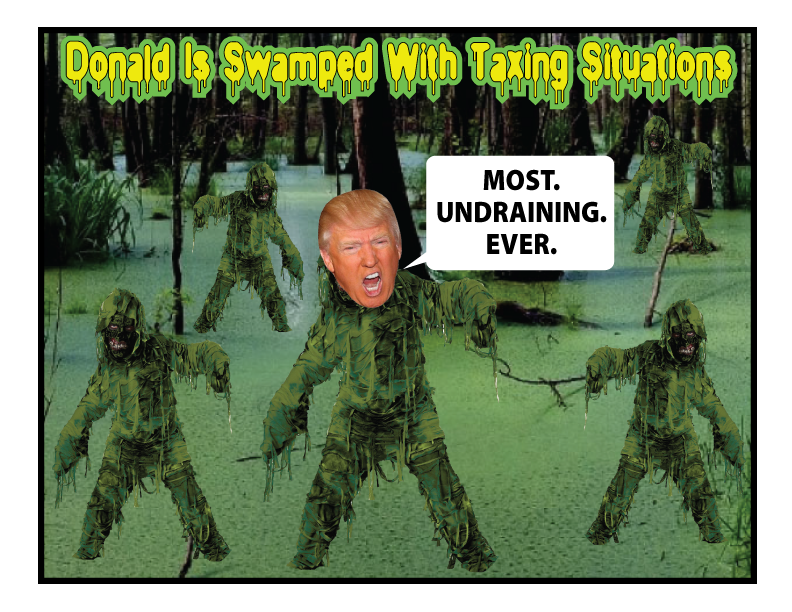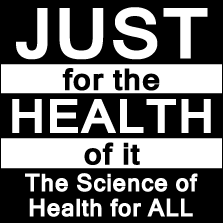Donald Trump’s promise to “Drain the swamp” from Washington, DC, is perhaps his most surreal promise of all. Today, President Donald Trump is campaigning for Senate candidate Roy Moore, who has been facing mounting credible evidence of his predatory sexual behavior, especially against teen girls. Roy Moore has proven himself a liar, not that The Don has a problem with that. With Roy Moore, Donald Trump wants to fill the swamp, officially bringing pedophilia to the Senate. Of course, Trump’s cabinet and advisers are replete with long-time corporate and political insiders. Trumpcare and the Republican tax scam were literally written by corporate tools and lobbyists. To top it off, the Trump administration is on course to be the most corrupt Washington administration in history. The Don may make Richard “Tricky Dick” Nixon look like an amateur criminal. As Prez Donald Trump becomes increasingly unhinged, swamped with taxing situations, he arrogantly declares, “MOST UNDRAINING. EVER.” Thus, I have created a free political poster: Donald Trump Swamped With Taxing Situations, Declares MOST UNDRAINING EVER! Please enjoy and feel free to share with friends and enemies.
For another perspective on the “drain the swamp” landscape, try this commentary, Trump Made the Swamp Worse. Here’s How to Drain It:
Donald Trump’s pledges to “drain the swamp” of corruption in Washington attest to his genius for unintentional irony. Nepotism, egregious conflicts of interest, flights on the public dime to see Wimbledon and the eclipse — the Beltway wetlands are now wilder and murkier than ever.
It would be a mistake, though, to dismiss the swamp metaphor on account of Mr. Trump’s hypocrisy. You can’t make sense of his shocking victory last year without reference to the downward spiral of public faith in governing elites and established institutions. Years of stagnating incomes, combined with dimming prospects for the future, have primed voters for the message that the system is “rigged” and that only an outsider not beholden to the corrupt establishment can clean it up.
In other words, one key to this populist moment in American politics is the link in the public mind between dysfunction in Washington and the economic malaise of the 21st century. An effective political response to this perilous moment begins with the recognition that this link is real — and that key changes in the policymaking process, supported by a major push from organized philanthropy, will be needed to turn things around.
The image of the swamp conveys a profound truth about the American economy. Our predicament of slow growth and sky-high inequality has many causes, but one important factor is the capture of the American political system by powerful insiders — big businesses, elite professionals, wealthy homeowners — that use it to entrench their own economic power. In so doing, they protect themselves from competition, fatten their bank accounts with diverted wealth and slow the creative destruction that drives economic growth.
Four key policy areas shed light on the growth of this political-economic swamp — financial regulation, intellectual property, occupational licensing and zoning. They show that the swamp isn’t confined to Washington; it can also be found in 50 state capitals and countless local jurisdictions.
Continue reading the main story
In the financial sector, a web of regulatory subsidies sustains financial institutions’ unhealthy reliance on extremely high levels of debt. These subsidies, including policies that strongly encourage mortgage securitization as well as the implicit promise to bail out “too big to fail” institutions, swell profits in the near term while increasing the systemic risk of a catastrophic meltdown in the long run. The result is a financial sector much bigger than the economy needs, chronic misallocation of capital and the diversion of some of the country’s top talent into counterproductive work. Luring people into excessive debt, draining their savings with hidden fees, inflating the next asset bubble — these and other dubious “contributions” by finance to the economy need to be curtailed.Intellectual property laws are supposed to encourage innovation by granting temporary monopolies to copyright and patent holders. But if those monopolies get too broad and too onerous, innovation takes a hit — and that is precisely what has happened, at the urging and for the benefit of Hollywood, Big Pharma and some interests in Silicon Valley.
Occupational licensing rules at the state level help explain why professionals in the United States are paid so much more than their peers in other countries. Primary care physicians, for example, make 50 percent more in the United States than in other advanced countries, and specialists do even better. State regulations protect the incomes of doctors, dentists, undertakers and optometrists — not to mention makeup artists and auctioneers — while also stifling innovation.
Increasingly severe constraints on building in high-income coastal cities inflate the asset values of affluent homeowners, contributing significantly to rising disparities in wealth. And by making housing unaffordable, they prevent the less well-off from moving to where the good-paying jobs are, reducing geographic and social mobility.
This regressive regulatory swamp isn’t a natural landscape; it grows because of forces in our political environment. The beneficiaries of upward redistribution are always far more organized than those who pay the costs. They can divert some of their artificially high profits into lobbying and policy research that bestow a patina of the public interest on schemes that are, in practice, legalized robbery. Drugmakers, for example, portray even the most modest retrenchment of patent law as catastrophic for American innovation, while financiers warn that any restraint on subsidized risk-taking (through higher capital requirements, for example) will starve American industry of the capital it needs to invest and grow.
This unequal battle for the minds of policymakers is particularly damaging at a time when the resources that Congress and the bureaucracy have for independent research have been systematically dismantled. In finance, in particular, Congress has a difficult time hiring and retaining staff with the technical knowledge and experience to assess the impact of new regulations, leaving them dependent on the abundant resources of the industry itself.
In addition, many regressive regulations are made in obscure places with limited participation, such as state licensing boards and town councils in charge of approving new housing. Insiders with narrow interests, whether self-serving professional groups or Nimby neighbors, have the motivation and resources to show up at poorly attended meetings and work the system, often at odds with the general public’s interest in low prices and economic opportunity.
Really draining the swamp means changing the policymaking process to shield it against insider takeover and manipulation. For starters, congressional staffs need to be expanded, upgraded and professionalized. Legislators would then be better able to make their own assessments of complex regulatory issues without having to depend on the biased expertise of industry lobbyists.
Philanthropists need to put their dollars behind a network of organizations to counter the organizational presence of the forces of upward redistribution. The Ford Foundation did this in the 1970s by investing in a network of environmental law firms like the Natural Resources Defense Council and the Environmental Defense Fund. More recently, the Eli and Edythe Broad, Walton Family, Robertson and other charitable foundations have made similar investments in educational reforms.
Whatever you think of the merits of these causes, the new interest groups funded by sustained philanthropy changed the political landscape in these issue areas, forcing policymakers to recognize that there were, in fact, two sides to be considered. A network of new organizations with the resources and expertise to compete with big banks, the medical lobby and other industry groups could have a similar impact today. Activist groups could show up regularly in all the obscure places where rules are set and make sure that someone speaks up for the public interest.
State and local governments need to institute regulatory review procedures that expose back-room deals to objective scrutiny. While cost-benefit analysis by the Office of Management and Budget is standard for new federal regulations, no such reviews are conducted when states propose to license new occupations or cities stymie new housing construction.
Courts at all levels need to be less deferential to regulatory schemes that — in contrast to environmental or labor regulation — have no justification other than the protection of incumbent interests. For example, courts could force legislatures to explicitly approve expansions in the scope of occupational licensing, depriving licensing boards of the power to do so in shadowy obscurity.
In the political arena, the issues of regressive regulation cut across the usual partisan and ideological battle lines, and so tend to be kept off the agenda by legislative leaders who emphasize issues that hold their caucus together. Libertarian-leaning conservatives and egalitarian liberals need to forge strange-bedfellows coalitions to tackle policies that are simultaneously bad for growth and inequality. In recent years, cross-party coalitions in the states have started to make progress on criminal justice reform. Opposition to upward redistribution can galvanize support for similar alliances on regulatory issues.
The administration of Donald Trump has shown no interest in draining the real swamp that is drowning America’s economy and corrupting its politics. If public-spirited Democrats and Republicans fail to do so, trust in democracy will continue to erode. And the next demagogue who cashes in by saying he alone can fix things is likely to be more disciplined and focused than Mr. Trump — and hence even more dangerous.


